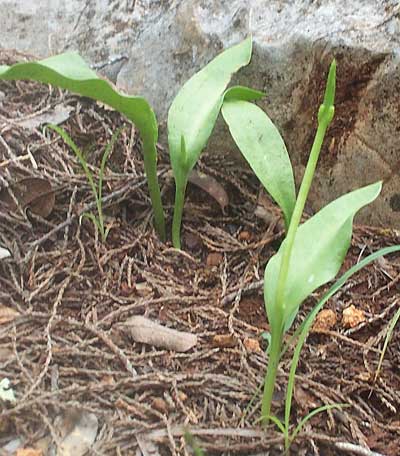Excerpts from Jim Conrad's
Naturalist Newsletter
from the August 24, 2007 Newsletter issued from Sierra Gorda Biosphere Reserve, QUERÉTARO, MÉXICO
ADDER'S-TONGUE FERNS
Often in the thin, red soil accumulating in any limestone outcrop's pits and hollows you find rare and unusual plants. That's because any plant growing there must be able to survive extreme conditions. Most of the time the soil there is dust-dry, but after rains the depressions may hold water, submerging the soil. Also, derived from limestone, the soil can be a bit alkaline.
Therefore, at Cocos as I hiked along I kept an eye on rock depressions filled with soil. It wasn't long until I was rewarded with a fine little colony of adder's-tongue ferns, seen below:

Though the plants were immature and hard to identify, I figured they were Limestone Adder's-tongues, OPHIOGLOSSUM ENGELMANNII, which I've often found in exactly such limestone depressions in Kentucky's "Mississippian Plateau" region, which is a karst landscape developed upon Mississippian-age limestone. That's my Cocos finds in one of our own Cretaceous-age limestone depressions in the picture.
Adder's-tongues are very primitive ferns famous not only for their curious appearance but also for this: Of all known living things on Earth, they have the highest chromosome number.
Pea plants have 14. Mice have 40. Humans have 46, pigeons have 80 and carp have 104. The adder's-tongue fern Ophioglossum reticulatum possesses 1260.
How did adder's-tongues get so many chromosomes? Through "polyploidy" -- a process by which the cell nuclei of an organism somehow end up with more than the usual two complete sets of chromosomes. It's thought that through evolutionary history adder's-tongue species may have undergone the polyploid-making process up to ten times. One of the most interesting features of polyploidy is that sometimes organisms of two different species, maybe even species from different genera, mate to produce polyploid offspring, and those offspring constitute completely new, self-reproducing species -- " instant evolution" as noted geneticist Doug Soltis calls it.
Therefore, one reason adder's-tongue ferns have so many chromosomes may be that, because they as a group appeared so early in evolutionary history, they've been around long enough for the polyploid-making process to have occurred several times among them.
In fact, adder's-tongue ferns are so primitive that genetic-sequencing studies indicate that they're not even "true ferns" -- members of the taxonomic Division Pteridophyta. Instead, often they are now placed in their own division, the Ophioglossophyta.